1950 Pacific typhoon season
The 1950 Pacific typhoon season has no official bounds; it ran year-round in 1950, but most tropical cyclones tend to form in the northwestern Pacific Ocean between June and December. These dates conventionally delimit the period of each year when most tropical cyclones form in the northwestern Pacific Ocean.
| 1950 Pacific typhoon season | |
|---|---|
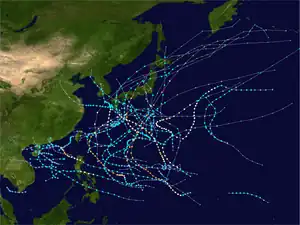 Season summary map | |
| Seasonal boundaries | |
| First system formed | April 12, 1950 |
| Last system dissipated | January 1, 1951 |
| Strongest storm | |
| Name | Clara |
| • Maximum winds | 230 km/h (145 mph) (1-minute sustained) |
| • Lowest pressure | 899 hPa (mbar) |
| Seasonal statistics | |
| Total storms | 18 |
| Typhoons | 12 |
| Super typhoons | 1 (unofficial) |
| Total fatalities | 544 total |
| Total damage | Unknown |
| Related articles | |
The scope of this article is limited to the Pacific Ocean, north of the equator and west of the international date line. Storms that form east of the date line and north of the equator are called hurricanes; see 1950 Pacific hurricane season. This would be the first season that Fleet Weather Center in Guam, predecessor agency to Joint Typhoon Warning Center, would take most of the responsibility in the basin, including naming the storms.[1] Before this season, the storms are identified and named by the United States Armed Services, and these names are taken from the list that USAS publicly adopted before the 1945 season started.[2][3]
Systems
Severe Tropical Storm One
| Severe tropical storm (CMA) | |
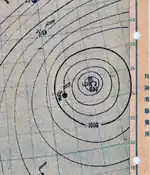  | |
| Duration | April 12 – April 15 |
|---|---|
| Peak intensity | 110 km/h (70 mph) (10-min); 984 hPa (mbar) |
Typhoon Doris
| Typhoon (JMA) | |
| Category 4 super typhoon (SSHWS) | |
 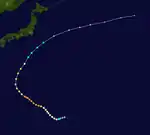 | |
| Duration | May 6 – May 14 |
|---|---|
| Peak intensity | 240 km/h (150 mph) (1-min); 922 hPa (mbar) |
Doris was an intense category 4 super Typhoon that mostly remained out to sea. It formed on May 6, peaked as a strong category 4, and then dissipated on May 14. Doris reached a very low pressure of 922 mbar.
Tropical Storm 02W
| Tropical storm (JMA) | |
| Tropical storm (SSHWS) | |
  | |
| Duration | June 5 – June 9 |
|---|---|
| Peak intensity | 65 km/h (40 mph) (1-min); 997 hPa (mbar) |
This storm impacted Taiwan.
Typhoon Elsie
| Typhoon (JMA) | |
| Category 1 typhoon (SSHWS) | |
 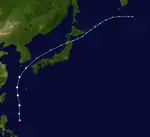 | |
| Duration | June 22 – June 24 |
|---|---|
| Peak intensity | 140 km/h (85 mph) (1-min); 981 hPa (mbar) |
CMA Severe Tropical Storm Six
| Severe tropical storm (CMA) | |
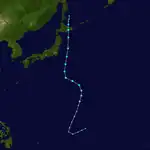 | |
| Duration | July 12 – July 15 |
|---|---|
| Peak intensity | 95 km/h (60 mph) (10-min); 990 hPa (mbar) |
Typhoon Flossie
| Typhoon (JMA) | |
| Tropical storm (SSHWS) | |
 | |
| Duration | July 15 – July 19 |
|---|---|
| Peak intensity | 110 km/h (70 mph) (1-min); 993 hPa (mbar) |
Typhoon Grace
| Typhoon (JMA) | |
| Category 1 typhoon (SSHWS) | |
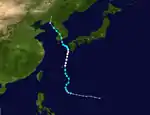 | |
| Duration | July 15 – July 22 |
|---|---|
| Peak intensity | 130 km/h (80 mph) (1-min); 981 hPa (mbar) |
Typhoon Grace impacted Korea and Japan.
Tropical Storm Helene
| Tropical storm (JMA) | |
| Tropical storm (SSHWS) | |
 | |
| Duration | July 24 – August 1 |
|---|---|
| Peak intensity | 95 km/h (60 mph) (1-min); 990 hPa (mbar) |
This storm stalled near Japan and accelerated towards China.
Tropical Storm Thirteen
| Tropical storm (CMA) | |
 | |
| Duration | August 2 – August 4 |
|---|---|
| Peak intensity | 75 km/h (45 mph) (10-min); 992 hPa (mbar) |
Tropical Storm Fifteen
| Tropical storm (CMA) | |
 | |
| Duration | August 3 – August 4 |
|---|---|
| Peak intensity | 75 km/h (45 mph) (10-min); 998 hPa (mbar) |
Tropical Storm Sixteen
| Tropical storm (JMA) | |
 | |
| Duration | August 4 – August 6 |
|---|---|
| Peak intensity | 75 km/h (45 mph) (10-min); 996 hPa (mbar) |
This storm was the third and last storm consecutively to make landfall on Japan.
Typhoon Ida
| Typhoon (JMA) | |
| Category 1 typhoon (SSHWS) | |
 | |
| Duration | August 9 – August 22 |
|---|---|
| Peak intensity | 140 km/h (85 mph) (1-min); 973 hPa (mbar) |
Tropical Depression Twenty
| Tropical depression (JMA) | |
 | |
| Duration | August 10 – August 14 |
|---|---|
| Peak intensity | 95 km/h (60 mph) (10-min); 990 hPa (mbar) |
This storm impacted Japan and South Korea. This storm also occurred in the Korean War, where Korean soldiers were battling in South Korea during the storm's impact on land.
Severe Tropical Storm Twenty-one
| Severe tropical storm (CMA) | |
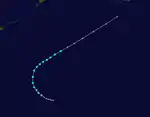 | |
| Duration | August 11 – August 14 |
|---|---|
| Peak intensity | 110 km/h (70 mph) (10-min); 980 hPa (mbar) |
Severe Tropical Storm Twenty-one was a severe tropical storm that remained in open waters.
Severe Tropical Storm Twenty-three
| Tropical storm (JMA) | |
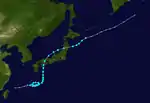 | |
| Duration | August 14 – August 22 |
|---|---|
| Peak intensity | 110 km/h (70 mph) (10-min); 990 hPa (mbar) |
Severe Tropical Storm Twenty-Three tracked through Japan.
Typhoon Jane
| Typhoon (JMA) | |
| Category 3 typhoon (SSHWS) | |
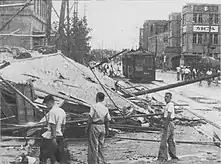  | |
| Duration | August 29 – September 3 |
|---|---|
| Peak intensity | 185 km/h (115 mph) (1-min); 943 hPa (mbar) |
Typhoon Jane struck the island of Shikoku in Japan on 3 September. Resulting flooding and landslides killed 539 people.
In late August, a depression formed and quickly intensified into a tropical storm and was given the name Jane. The storm drifted west-northwestward and intensified into a typhoon. Jane gradually curved to the north and intensified to a category 2 typhoon. Jane shortly reached category 3 status and peak intensity at 185 km/h (115 mph). The typhoon accelerated to the north-northeast and weakened to a category 2 storm and made landfall in the modern-day Osaka-Kobe-Kyoto area. Jane crossed Kyoto Prefecture and weakened to a tropical storm and crossed the Noto Peninsula and reentered the Sea of Japan and passed just west of Sado Island. The storm struck eastern Aomori Prefecture and crossed the Tsugaru Straits and made a final landfall on the south coast of Hokkaido Prefecture. Jane crossed Hokkaido and dissipated south of the Kuril Islands.
Typhoon Kezia
| Typhoon (JMA) | |
| Category 3 typhoon (SSHWS) | |
 | |
| Duration | September 4 – September 14 |
|---|---|
| Peak intensity | 185 km/h (115 mph) (1-min); 945 hPa (mbar) |
On September 13 Typhoon Kezia hit part of the fleet off Kyushu.
P-51 Mustangs belonging to No. 77 Squadron RAAF were grounded at Iwakuni because of the typhoon on September 13 and 14.[4]
There was great damage in western Japan. In Japan, 30 dead, 19 missing people, 35 injured. The total damage and breakage of the house is 4,836. There are 121,1924 inundated houses. In the Itsukushima Shrine the building was damaged, the Kintai Bridge was lost.[5]
Severe Tropical Storm Twenty-six
| Severe tropical storm (CMA) | |
 | |
| Duration | September 6 – September 8 |
|---|---|
| Peak intensity | 95 km/h (60 mph) (10-min); 995 hPa (mbar) |
This storm tracked through Vietnam and Laos.
Tropical Storm Lucretia-Nancy
| Tropical storm (JMA) | |
| Tropical storm (SSHWS) | |
 | |
| Duration | September 14 – September 19 |
|---|---|
| Peak intensity | 100 km/h (65 mph) (1-min); 987 hPa (mbar) |
Typhoon Missatha
| Typhoon (JMA) | |
| Category 1 typhoon (SSHWS) | |
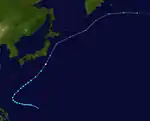 | |
| Duration | September 13 – September 18 |
|---|---|
| Peak intensity | 130 km/h (80 mph) (1-min); 984 hPa (mbar) |
Typhoon Missatha paralleled Japan.
Typhoon Ossia
| Typhoon (JMA) | |
| Category 3 typhoon (SSHWS) | |
 | |
| Duration | September 27 – October 6 |
|---|---|
| Peak intensity | 185 km/h (115 mph) (1-min); 966 hPa (mbar) |
Typhoon Ossia impacted the Philippines.
Typhoon Petie
| Typhoon (JMA) | |
| Category 2 typhoon (SSHWS) | |
 | |
| Duration | October 18 – October 24 |
|---|---|
| Peak intensity | 165 km/h (105 mph) (1-min); 978 hPa (mbar) |
Severe Tropical Storm Thirty-five
| Severe tropical storm (CMA) | |
 | |
| Duration | October 26 – October 31 |
|---|---|
| Peak intensity | 95 km/h (60 mph) (10-min); 995 hPa (mbar) |
Typhoon Ruby-Anita
| Typhoon (JMA) | |
| Category 3 typhoon (SSHWS) | |
 | |
| Duration | October 27 – October 31 |
|---|---|
| Peak intensity | 185 km/h (115 mph) (1-min); 918 hPa (mbar) |
Typhoon Billie
| Typhoon (JMA) | |
| Category 1 typhoon (SSHWS) | |
 | |
| Duration | November 4 – November 9 |
|---|---|
| Peak intensity | 150 km/h (90 mph) (1-min); 985 hPa (mbar) |
Typhoon Clara
| Typhoon (JMA) | |
| Category 4 typhoon (SSHWS) | |
 | |
| Duration | November 4 – November 12 |
|---|---|
| Peak intensity | 230 km/h (145 mph) (1-min); 899 hPa (mbar) |
Tropical Storm Delilah
| Tropical storm (JMA) | |
| Tropical storm (SSHWS) | |
 | |
| Duration | November 19 – November 25 |
|---|---|
| Peak intensity | 110 km/h (70 mph) (1-min); 989 hPa (mbar) |
This tropical storm affected the Philippines.
Storm names
21 names were used during the season, the first being Doris and the last being Fran.
| 1. Doris | 12. Ossia |
| 2. Elsie | 13. Petie |
| 3. Flossie | 14. Ruby |
| 4. Grace | 15. Salome |
| 5. Helene | 16. Anita |
| 6. Ida | 17. Billie |
| 7. Jane | 18. Clara |
| 8. Kezia | 19. Delilah |
| 9. Lucretia | 20. Ellen |
| 10. Missatha | 21. Fran |
| 11. Nancy |
Names decommissioned
For unknown reasons, the names Helene, Jane, Kezia, Lucretia, Missatha, Ossia, Petie, Salome and Delilah were replaced with Helen, June, Kathy, Lorna, Marie, Olga, Pamela, Sally and Dot.
See also
References
- Joint Typhoon Warning Center 50th Anniversary May 1959 – May 2009. April 29, 2009. Archived from the original on July 17, 2016. Retrieved November 14, 2014.
- Landsea, Christopher W; Dorst, Neal M (June 1, 2014). "Subject: Tropical Cyclone Names: B1) How are tropical cyclones named?". Tropical Cyclone Frequently Asked Question. United States National Oceanic and Atmospheric Administration's Hurricane Research Division. Archived from the original on March 29, 2015.
- Cry, George (July 1958). Bristow, Gerald C (ed.). "Naming hurricanes and typhoons". Mariners Weather Log. 2 (4): 109. hdl:2027/uc1.b3876059. ISSN 0025-3367. OCLC 648466886.
- "RAAF Form A.50 - No. 77 Squadron, RAAF - September 1950". AviationHeritage.org. Retrieved 28 June 2016.
- "錦帯橋の歴史". 岩国市観光振興課. 2012-09-21. Archived from the original on 2012-03-12. Retrieved 2019-01-15.
- Pagasa - Dost - Dost Service Institutes
External links
- Unisys season tracks
- List of DOD publishing organizations and basins covered for the entire 1945-2000 period.

